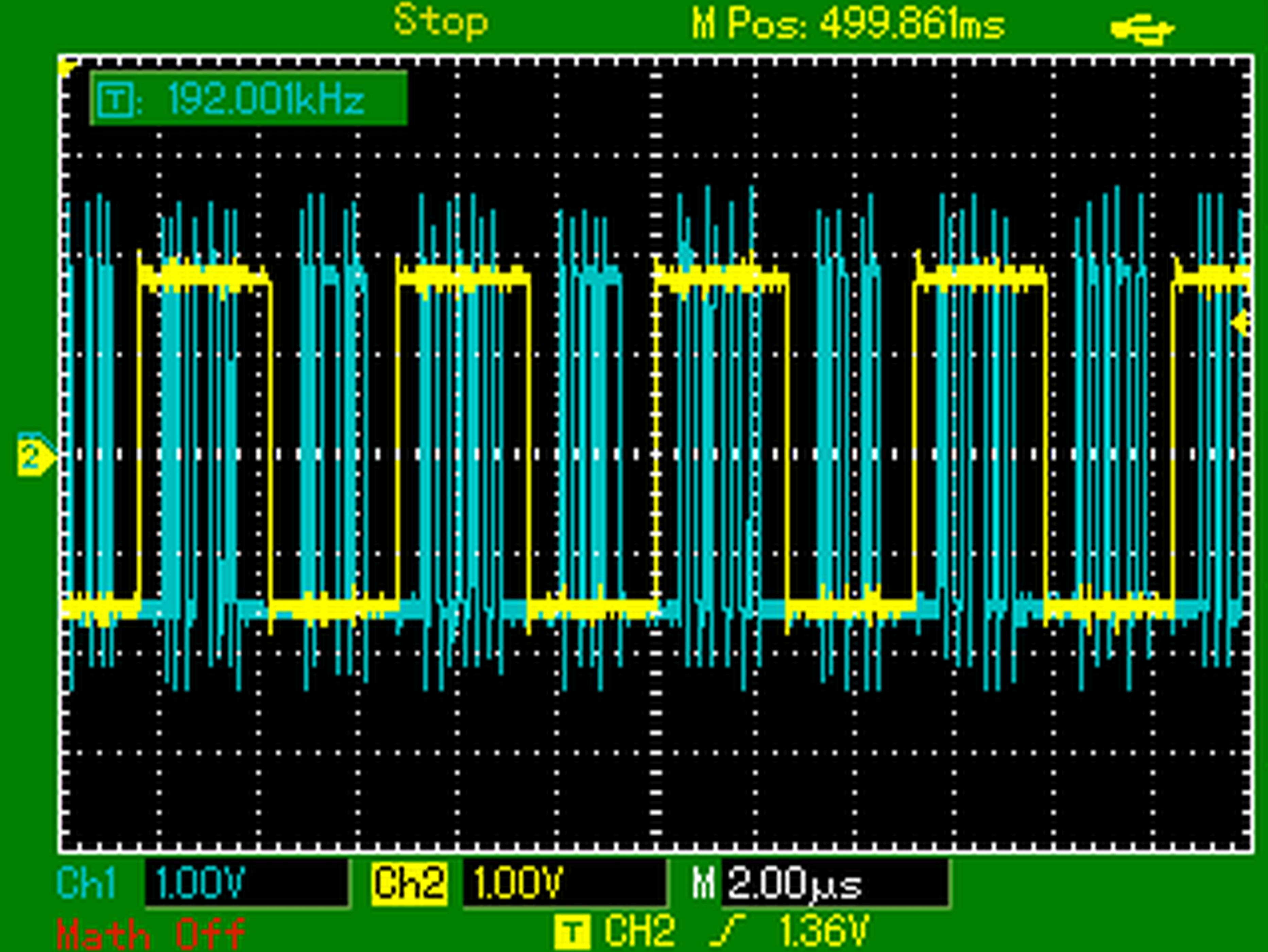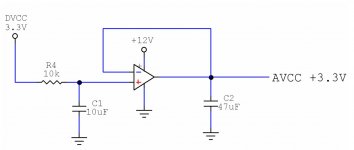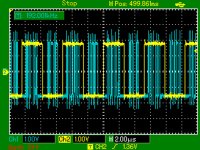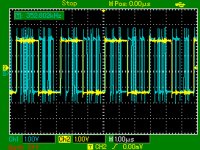Sorry for any confusion guys. I would think that using Lt3045 as the reference voltage for an opamp AVCC power supply should be okay if the LT3045 output is filtered as ESS recommends. They use a 10k and 10uf low pass filter in front of the AVCC opamp as shown in the schematic below.
If using the LT3045 to provide Vcc for the opamp, then you might need to use a voltage divider to get the 3.3v, then filter that to use as the opamp input.
Also, I would agree that using LT3045 as a regulator for opamp +15v should be fine. It should also be fine for the other power supplies, just not AVCC.
I was just worried because some people may get the idea LT3045 can be used as a quick and easy way to power AVCC.
Regarding voltage regulators, does anyone have a preference for an adjustable negative regulator?
One thing I am doing with my linear supplies is using hexfred rectifiers. They are very good fast turn-off and soft-recovery to help prevent or reduce HF ringing due to power transformer parasitic reactances. That stuff can be hard to get rid of once it is produced. Better not to produce it in the first place, would be my point of view.
If using the LT3045 to provide Vcc for the opamp, then you might need to use a voltage divider to get the 3.3v, then filter that to use as the opamp input.
Also, I would agree that using LT3045 as a regulator for opamp +15v should be fine. It should also be fine for the other power supplies, just not AVCC.
I was just worried because some people may get the idea LT3045 can be used as a quick and easy way to power AVCC.
Regarding voltage regulators, does anyone have a preference for an adjustable negative regulator?
One thing I am doing with my linear supplies is using hexfred rectifiers. They are very good fast turn-off and soft-recovery to help prevent or reduce HF ringing due to power transformer parasitic reactances. That stuff can be hard to get rid of once it is produced. Better not to produce it in the first place, would be my point of view.
Attachments
Last edited:
Well I took off the Cset 33uF chinesium electrolytic caps off the LT3042 and in place put on a hybrid set of caps I had lying around. It consisted of 3x4.7Uf polypropylene with a small bypass. The effects of the 33uF is now gone and it actually improved the midrange. In theory, there really should be no discernible difference from a technical standpoint but it was clear.
It's possible to speculate all sorts of reasons why it made a difference. One possibility is that all capacitors have a non static leakage current, and as the reference is a high impedance node, any current leakage will change the value of the reference. Film caps tend to have lower leakage than electrolytics, so perhaps this is why they sound better here. Films caps also tend to have lower distortion, and are better in other parameters too.
All this makes an apparently simple exercise of choosing a reference capacitor rather complex, as we are nearing the dark arts of cap swapping. Of course a battery nullifies these issues, which is perhaps part of their appeal.
I was just worried because some people may get the idea LT3045 can be used as a quick and easy way to power AVCC.
It can. It's an excellent regulator.
I would hope people wouldn't use it for AVCC. Of course, it depends on how far one wants to go with DAC modding.
ESS says the ES9038Q2M DAC chip can get as good as -120dB distortion and -122dB noise, IIRC. To get close to those numbers great attention has to be paid to little details. That is my goal with this project, and the advice I give is directed at ending up with a very good DAC. For people who share that same goal, I would not recommend using LT3045 directly as an AVCC power source. Maybe it would be okay if Cset is 22uf, I don't know. But since I don't know, and in the absence of measurement equipment to show the noise spectrum, I probably wouldn't use it.
ESS says the ES9038Q2M DAC chip can get as good as -120dB distortion and -122dB noise, IIRC. To get close to those numbers great attention has to be paid to little details. That is my goal with this project, and the advice I give is directed at ending up with a very good DAC. For people who share that same goal, I would not recommend using LT3045 directly as an AVCC power source. Maybe it would be okay if Cset is 22uf, I don't know. But since I don't know, and in the absence of measurement equipment to show the noise spectrum, I probably wouldn't use it.
Mark, have a good read of the LT3045's DS; I haven't done a careful analysis, but you're in the same ballpark of regulation and noise as having a final Sallen-Key 49720, if not better. It's a stupendous part. Edit: spot noise is 2.2 nV/rtHz at 10KHz, so doing better than a 49720. And provides a cleaner layout.
Similarly, the primary motivation to bypassing (and no need for huge capacitance) a battery supply in this application is bandwidth, not noise. There were a couple (I'm having to reach into the depths of my brain) papers from NIST on their autocorrelated measurements and a rather extreme preamp to measure battery noise of larger cells. They're very quiet. Gerhard has posted some of his efforts as well.
Similarly, the primary motivation to bypassing (and no need for huge capacitance) a battery supply in this application is bandwidth, not noise. There were a couple (I'm having to reach into the depths of my brain) papers from NIST on their autocorrelated measurements and a rather extreme preamp to measure battery noise of larger cells. They're very quiet. Gerhard has posted some of his efforts as well.
Question is, what if I hang 47uf directly on the output of the 49720 as ESS recommends? With LT3045 they say it doesn't help in the data sheet. Same thing true with 49720?
Also, how do you get -122dB noise out of the DAC if AVCC has no PSRR and the AVCC supply has noise right around there or worse? Not clear to me I know the answer to all those things without measuring something.
Also, how do you get -122dB noise out of the DAC if AVCC has no PSRR and the AVCC supply has noise right around there or worse? Not clear to me I know the answer to all those things without measuring something.
Last edited:
That's good to know; FWIW, here's Gerhard's measurement on the 3042: VoltageRegulators | Output noise of some voltage regulators.… | Flickr
Have a search through "gerhard" and "lt3042" and have a good read. What's the corner frequency on the 47 uF anyhow? Not being combative, purely curious.
At 2 nV/rtHz and it's super high PSRR, the lt3042/45 are doing battle with a properly designed 797-level super-regulator. Don't think a low-pass buffer is in that ballpark, but haven't done the hard analysis. At best, we're talking about 4-5 nV between the En and In of the 49720.
Edit: ADM7150 Datasheet and Product Info | Analog Devices
Fixed 3.3v option!
Have a search through "gerhard" and "lt3042" and have a good read. What's the corner frequency on the 47 uF anyhow? Not being combative, purely curious.
At 2 nV/rtHz and it's super high PSRR, the lt3042/45 are doing battle with a properly designed 797-level super-regulator. Don't think a low-pass buffer is in that ballpark, but haven't done the hard analysis. At best, we're talking about 4-5 nV between the En and In of the 49720.
Edit: ADM7150 Datasheet and Product Info | Analog Devices
Fixed 3.3v option!
Last edited:
That's good to know; FWIW, here's Gerhard's measurement on the 3042: VoltageRegulators | Output noise of some voltage regulators.… | Flickr
Have a search through "gerhard" and "lt3042" and have a good read. What's the corner frequency on the 47 uF anyhow? Not being combative, purely curious.
At 2 nV/rtHz and it's super high PSRR, the lt3042/45 are doing battle with a properly designed 797-level super-regulator. Don't think a low-pass buffer is in that ballpark, but haven't done the hard analysis. At best, we're talking about 4-5 nV between the En and In of the 49720.
Edit: ADM7150 Datasheet and Product Info | Analog Devices
Fixed 3.3v option!
Wow. Did the search. Some great posts by Gerhard!
Based on what I am hearing with the LT3042 powering AVCC directly, there is stuff happening at the lower frequencies that the datasheets does not quite expose. What that is I am not qualified. But I am certain that there is some sensitivity as to how it is implemented. Now what I initially found when I switched from using the AMS1117 was there was indeed improvement in the low end but the effect on the higher frequencies was extremely apparent. Since that, changing implementations did not change the high frequencies as much as the initial changeover but the changes to the low end and midbass was apparent. Maybe there is more to he had by using an OP AMP AVCC which is possibly more stable or even easier to implement at lower frequencies and the effect at higher frequencies might be the same as the LT3042. This could be a better combination.
I will soon find out myself when I wire up and use an OP amp based AVCC..with the limitations that it is not surface mount stuff. The power to the OP amp will be driven by something just a bit less than superreg grade and the 3.3V reference will be taken directly from the LT3042 and then post filtered with the 10k and 10uF ( film caps).
I will soon find out myself when I wire up and use an OP amp based AVCC..with the limitations that it is not surface mount stuff. The power to the OP amp will be driven by something just a bit less than superreg grade and the 3.3V reference will be taken directly from the LT3042 and then post filtered with the 10k and 10uF ( film caps).
Just got back from a trip out to visit Richard Marsh. He graciously offered to measure my DAC's performance. THD+N at 1kHz out of the DAC is less than -120dB. Out of the headphone amp is around -105dB. i expected the HPA to worse than the DAC, about like that.
Curiously, we found a lot of spurious peaks from the DAC down at -130dB or below which were reduced a lot by me just putting my arms over the DAC (it still isn't in a case). Found the peaks were greatly attenuated by holding my finger on the DAC chip (Richard's idea). Maybe that's why ESS talks about using analog and digital ground planes under different parts of the DAC, just a guess.
All measurements were taken with a 24/44 test sine wave upsampled by the SRC4392 to 192KHz. Briefly tried it without the SRC and with test signal direct into the DAC SPDIF input while were trying to chase down the -130dB spurs, but THD got noticeably worse without the SRC so I put it back in the circuit. (not surprised, DACs usually sound better at higher sample rates).
Didn't bother trying to tweak harmonic distortion compensation since THD and harmonics where already low enough.
Richard loaned me an HF AC voltmeter to see if I could use it to help track down and minimize the DAC spurs, not that they really matter. Just out of curiosity.
When the DAC is finally boxed up in a case and after I see if I can use the AC voltmeter to help with anything during that process, I will make another trip over to Richard's and perhaps have some more to report after that.
Minimum phase, slow transition reconstruction filter used for all measurements.
Curiously, we found a lot of spurious peaks from the DAC down at -130dB or below which were reduced a lot by me just putting my arms over the DAC (it still isn't in a case). Found the peaks were greatly attenuated by holding my finger on the DAC chip (Richard's idea). Maybe that's why ESS talks about using analog and digital ground planes under different parts of the DAC, just a guess.
All measurements were taken with a 24/44 test sine wave upsampled by the SRC4392 to 192KHz. Briefly tried it without the SRC and with test signal direct into the DAC SPDIF input while were trying to chase down the -130dB spurs, but THD got noticeably worse without the SRC so I put it back in the circuit. (not surprised, DACs usually sound better at higher sample rates).
Didn't bother trying to tweak harmonic distortion compensation since THD and harmonics where already low enough.
Richard loaned me an HF AC voltmeter to see if I could use it to help track down and minimize the DAC spurs, not that they really matter. Just out of curiosity.
When the DAC is finally boxed up in a case and after I see if I can use the AC voltmeter to help with anything during that process, I will make another trip over to Richard's and perhaps have some more to report after that.
Minimum phase, slow transition reconstruction filter used for all measurements.
Last edited:
What's the corner frequency on the 47 uF anyhow?
I don't know. There isn't any well-defined resistor. Don't know that the opamps are characterized under that condition. At power-on current limit until cap is charged then go linear? Try it and see?
Richard Marsh. Wow. I always read his articles way way back in the Audio Amateur days and eventually built one of his pre preamp designs. I have it lying around now somewhere in a box as I do not have a moving coil right now. Nice to see Richard is still contributing to this hobby.
It's only such a slight improvement in the presence of LT3045 (instead AMS)? Did you do the measurements using the unmodded board using 1-2 LDO, and did you powered the controller from the same AMS? I wonder if this level still remained after full modding?!
well, I have been doing stepwise mods measuring bulk THD to follow what direction they go. first off, insufficient AVCC decoupling for the board was demonstrated earlier in the in the thread (JensH/vacuphile). addition of extra caps brought some -6dB improvement. next question was whether lowering 3.3V regulator noise would bring any improvement. I soldered a 3 pin socket instead of AMS1117 in order to have easy changing. going from AMS1117 (about 900nV noise) to LT1963 (about 125nV noise) and to LT3045 (about 2nV noise) did not improve distortion much. LT3045 module was purchased from ldovr.com, what I believe is a quality product.
1kHZ 0bB test signal was generated by a PC running Daphile, upsampled to 352kHZ. USB to I2S transport by XMOS and distortion measurement with EMU0202 modified according @vicnic USB sound card for audio spectrum analysis .
there were audible differences with different regulators, but for a time being I will stick with THD measurements.
the next thing to do is to put an I/V stage of course, but since requirement of clean Vref, I have decided to build 2 discrete 3.3V regulators powered by a separate PS. probably simple series type with an op amp as error amplifier will be good enough. at the moment I do not have any better voltage reference for them as an old LM431. hopefully with a LPF it will be not too noisy.
Last edited:
hi, therte,
I have been using ver 1.04 board for a year, direct connect raspberry pi 3 via I2S, I found this DAC is the best sounding for my 56 years DIY audio experience.
The board modification is:
01 Removed 7808, +5V connect to raspberry pi power supply, 7.5V ac, 2 X 10,000uf and 7805.
02 Two 1117 for L and R AVCC 3.3V power supplys, 6.5V ac, 10,000uf.
03 10K port as volume control.
18+18V ac, 4 X 10,000uf, 7815 and 7915 for +-15V power supply.
The transformer is DIY by myself.
My system is very simple:
12" Gold Tannoy speakers, DIY crossovers, DIY 300L cabinets.
Fostex T500A super tweeters.
Harman Kardon AVR 7000, only using two channels of power amp section, direct connect to 9038 board RCA out.
Cerwin-Vegal CAV 118 18" sub, in a 200L cabinet, the original PA cabinet is retired, direct connect to 9038 board RCA out.
No preamp.
Volumio Music Player.
I am putting up something that I found about this board and Volumio Music Player on next post. I have very little knowledge on coding and never learn linux. Hopefully someone will get a solution for that.
English is not my first language, please correct me if there is something not right. Thanks
I have been using ver 1.04 board for a year, direct connect raspberry pi 3 via I2S, I found this DAC is the best sounding for my 56 years DIY audio experience.
The board modification is:
01 Removed 7808, +5V connect to raspberry pi power supply, 7.5V ac, 2 X 10,000uf and 7805.
02 Two 1117 for L and R AVCC 3.3V power supplys, 6.5V ac, 10,000uf.
03 10K port as volume control.
18+18V ac, 4 X 10,000uf, 7815 and 7915 for +-15V power supply.
The transformer is DIY by myself.
My system is very simple:
12" Gold Tannoy speakers, DIY crossovers, DIY 300L cabinets.
Fostex T500A super tweeters.
Harman Kardon AVR 7000, only using two channels of power amp section, direct connect to 9038 board RCA out.
Cerwin-Vegal CAV 118 18" sub, in a 200L cabinet, the original PA cabinet is retired, direct connect to 9038 board RCA out.
No preamp.
Volumio Music Player.
I am putting up something that I found about this board and Volumio Music Player on next post. I have very little knowledge on coding and never learn linux. Hopefully someone will get a solution for that.
English is not my first language, please correct me if there is something not right. Thanks
Last week installed Volumio 2 ES9028Q2M Hardware Volume plugin,
Forum Audiophonics.fr • Consulter le sujet - Volumio 2 Installation Plugin ES9028Q2M Volume Hardware.
Apart from the 44.1/16 all other formats are working okay with ver 1.04 ES9038Q2M board. Play some 352.8/24 files feeling slightly better than the Pi DAC driver. Check the waveform, got the results as follow:

http://www.diyaudio.com/forums/attachment.php?attachmentid=679962&stc=1&d=1526036890
This clearly shows the Pi DAC driver not play the 385.2K but 192K on Volumio. If the problem playing 44.1/16 is solved the ES9028 driver is good.
Forum Audiophonics.fr • Consulter le sujet - Volumio 2 Installation Plugin ES9028Q2M Volume Hardware.
Apart from the 44.1/16 all other formats are working okay with ver 1.04 ES9038Q2M board. Play some 352.8/24 files feeling slightly better than the Pi DAC driver. Check the waveform, got the results as follow:
http://www.diyaudio.com/forums/attachment.php?attachmentid=679962&stc=1&d=1526036890
This clearly shows the Pi DAC driver not play the 385.2K but 192K on Volumio. If the problem playing 44.1/16 is solved the ES9028 driver is good.
Attachments
- Home
- Source & Line
- Digital Line Level
- ES9038Q2M Board


